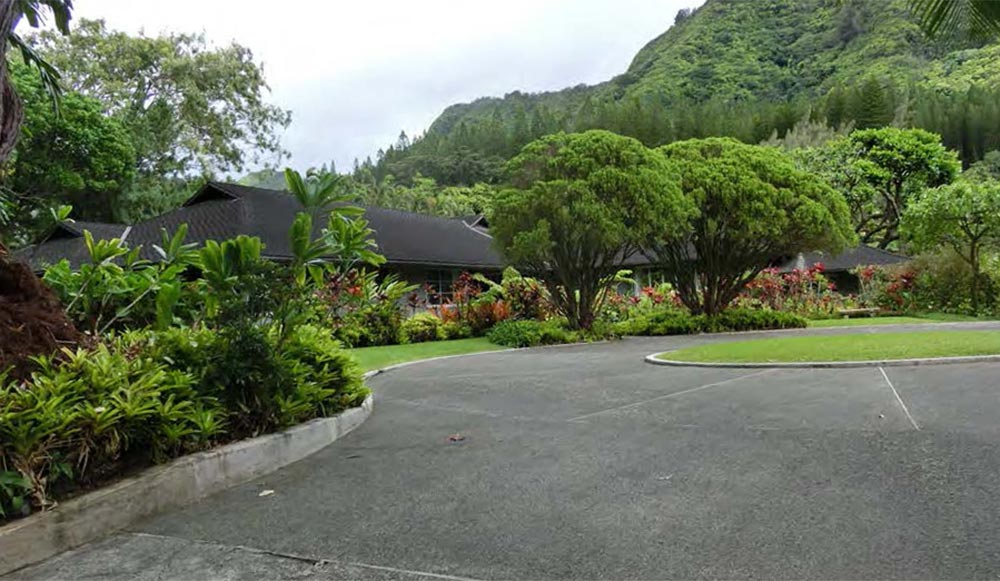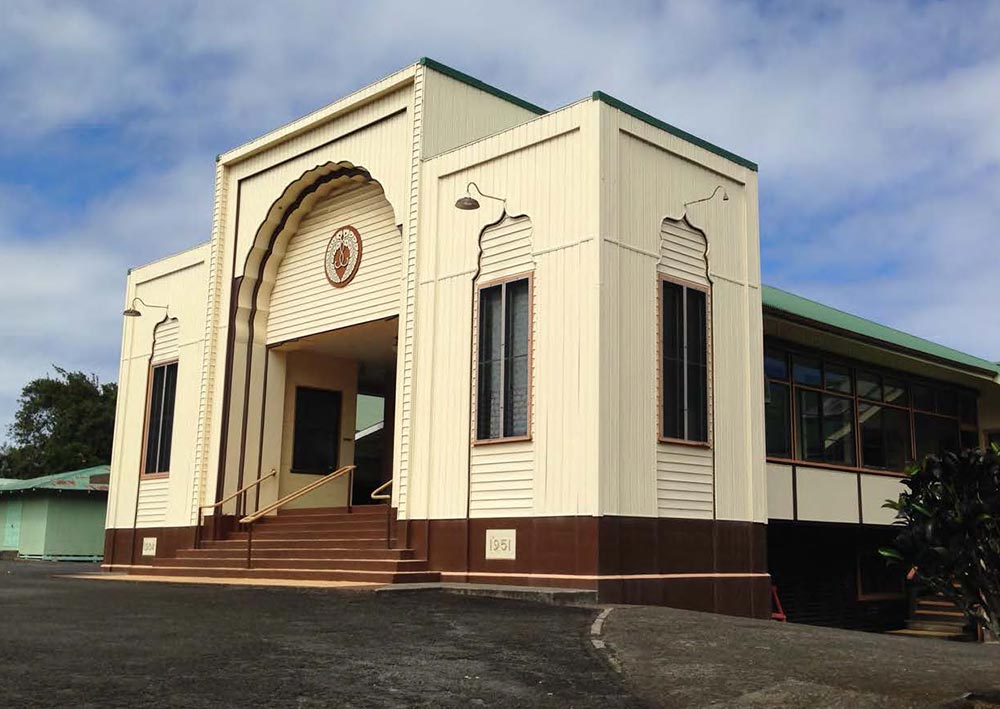The Hawai‘i Historic Places Review Board added eight properties to the Hawai‘i Register of Historic Places in March 2021.
Properties are eligible for inclusion in the register if they meet one or more criteria of historic significance: A) association with broad patterns or events; B) associations with historic individuals; C) architecture and design; or D) likely to yield important information. Click on the links to access the Register nomination forms of each property.
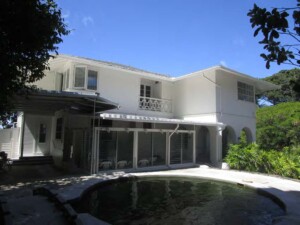 Dr. Hans and Clara Zimmerman Residence, O‘ahu
Dr. Hans and Clara Zimmerman Residence, O‘ahu
Constructed in 1930, the Dr. Hans and Clara Zimmerman Residence is significant as a good example of Mediterranean Revival architecture in a modern style. Architect Ray Morris incorporated Spanish Mission elements including stucco and round arches. Modern elements include built-in shelves and hutch, an Asian motif in the balustrade (common in Hawai‘i at the time), geometric design cabinets and stairway using sheet metal ornamentation. The modern style gained popularity as a residential form in Hawaii during the late 1930s. The house was originally a single-story Mediterranean style, masonry dwelling to which a frame second story was added in 1939. The Zimmerman Residence presents a distinct statement of the emerging tropical modern form, as a result of its blending the modern style with the pre-existing Mediterranean style house. The general hallmarks of the Mediterranean revival style such as the first story’s stucco walls, the round arched openings of the porches, and the rear and side porch’s framed round arches with keystones, remain, but are subservient to the more tropical modern aspects of the house.
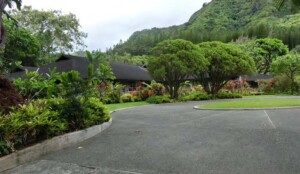 Charles and Alice Hite Residence, O‘ahu
Charles and Alice Hite Residence, O‘ahu
The Charles and Alice Hite Residence, built in 1941, is situated on Old Pali Road in Nu‘uanu Valley. The residence is a good example of the early 1940s Regional style. The single-story house was designed by Albert Ely Ives, a prominent architect in Hawai‘i during the 1930s through the 1950s. Notable features include acid stained concrete floors, beveled doors, ‘ōhi‘a floors and a double pitched, hip-gabled roof with overhanging eaves and exposed rafter tails. The home is also significant for its associations with the history of art in Hawai‘i, containing a rare example of prominent Honolulu artist A. S. MacLeod’s work. A fresco frieze executed depicting everyday life in ancient Hawai‘i is incorporated into the architecture. MacLeod was one of the preeminent artists in Hawai‘i during the pre-World War II period and remained active in Honolulu’s art world post-war. He had several one man shows at the Honolulu Academy of Arts and a number of private galleries in Honolulu, as well as in galleries and exhibitions in San Francisco, Vancouver, Philadelphia, and New York.
 James and Tomi Knaefler Residence, O‘ahu
James and Tomi Knaefler Residence, O‘ahu
The Knaefler Residence is significant as a modern style house built in the 1960s with strong Japanese influences. Features include a redwood tongue in groove and pitched roof, open beamed ceilings, cork floor, screen walls, built in cabinets, drawers and desk and a totally open bedroom with shoji to close it off. The floor is shiplap siding. The bathroom includes a furo (deep tub) and small tile. The house, built in three phases (1960, 1967, 1977) was the work of master architect Stephen Oyakawa. Oyakawa, who was born in Kahalu‘u, worked for Frank Lloyd Wright until Wright’s death. Oyakawa then returned to Honolulu and opened his own firm. He designed several well-known buildings, including the Kapahulu, Liliha, and ‘Aiea Public Libraries, Moanalua Intermediate School, and circular shaped buildings on the University of Hawai‘i campus.
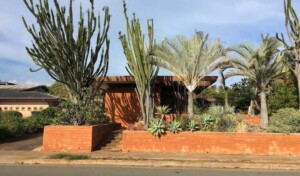 House for Dr. & Mrs. Katsumi Miyano, O‘ahu
House for Dr. & Mrs. Katsumi Miyano, O‘ahu
The House for Dr. & Mrs. Kasumi Miyano was built in 1962 and is significant as the venue in its early years for several Womenʻs Dental Auxiliary Club meetings, as Dr Miyano was a local dentist, and his wife, Florence was an active club member. The residence is a Mid-Century creation of master architect Stephen Oyakawa, a graduate of McKinley High School, and one of Frank Lloyd Wright’s apprentices and coworkers.
A few of the many design elements reminiscent of Wright’s style include the strong geometric L-shaped plan and dominant horizontal lines featured in its design, which have evolved from the requirements of the building’s function, site, circulation, and climate. Character-defining features include a flat cantilevered roof with broad overhanging eaves and outward projecting wood fascia boards that feature a continuous scalloped pattern. The upper portion of the burnt sienna-colored brick facade has the banding of clerestory windows that is also typical of Wright residences. The interiors feature many of their original custom built-in furniture and shelving, which has become ubiquitous with the style. The structure was designed to create a seamless composition integrating the natural landscape and natural coral bed above the road.
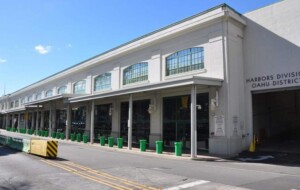 Pier 10 and 11 Buildings, O‘ahu
Pier 10 and 11 Buildings, O‘ahu
The Pier 10 and 11 structure is a two-story, steel-framed, concrete building located at Honolulu Harbor built in 1925 and 1927, respectively. The front façade runs parallel to Aloha Tower Drive (formerly Fort Street) and the rear façade fronts the water. Pier 10 was designed by Arthur Reynolds, who also created Hawai‘i Hall at the University of Hawai‘i at Mānoa, and his most well-known building, Aloha Tower. Architect Edwin Petitt, who became territorial architect for the department of public works and a founding member of AIA Honolulu, designed Pier 11. Distinctive features include more than 20 bays with pilaster and fixed windows, a parapet along the roofline and the building names in low relief.
The property is significant for its association with Hawaiian maritime history. The building serves as a representative of the evolution of Honolulu Harbor’s historical timeline from the transition of the harbor as a stopover point for whaling ships to a desirable visitor destination where passengers on Matson ships were welcomed by lei sellers and the Royal Hawaiian Band.
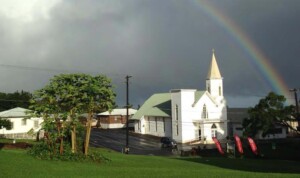 Honoka‘a Catholic Properties-Our Lady of Lourdes Catholic, Hawaiʻi Island
Honoka‘a Catholic Properties-Our Lady of Lourdes Catholic, Hawaiʻi Island
The Honokaʻa Catholic Properties include: Our Lady of Lourdes Sanctuary (1926); Our Lady of Lourdes Meeting Hall (1956); Rectory; Educational Building; and Our Lady of Lourdes and St. Georges cemeteries. It is significant as a small-town religious institution, centerpiece for religious and social activities, and catalyst for ethnic mixing and cultural exchanges in church and town during the Plantation Era. The church’s diverse congregation was comprised of Europeans, Portuguese, Puerto Ricans, Filipinos, and Native Hawaiians members.
The Honokaʻa Catholic Properties is also significant for its design with an eclectic melding of Plantation Vernacular style and late 19th and 20th century, late Gothic Revival style. Elements include single wall construction, a totan (corrugated iron) roof, Gothic windows and a peaceful, restful, spiritually centering atmosphere. The Meeting Hall building is a good example of early Plantation-Era design and construction that includes associated features such as post and pier and concrete pad foundation, tongue and groove single-board walls, wood panel doors, exposed rafter tails, and totan roof.
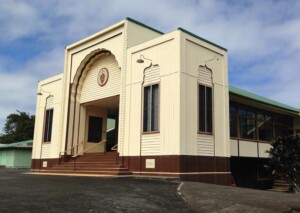 Honoka‘a Hongwanji Buddhist Mission, Hawaiʻi Island
Honoka‘a Hongwanji Buddhist Mission, Hawaiʻi Island
The Honokaʻa Hongwanji Buddhist Mission consists of the Hondō (sanctuary) with attached Priest’s Residence dedicated in 1951; Judo Dōjō (training room) constructed in 1929 with additions added in 1954 and 1960; Social Hall, constructed in 1970; and Honokaʻa Japanese Cemetery, located approximately a half mile outside of Honokaʻa on the Waipiʻo-Honokaʻa Highway. It is significant for its longtime association with the Hongwanji Buddhist Sect as a focal point of religious and social activities for generations of local Japanese since the first services were conducted in Honokaʻa in 1904. The Mission played a key role in establishing a sense of community as the quality of life at plantation camps improved, more families arrived and the transience of the labor force diminished. Also significant under Criterion C, each structure represents different architectural styles and characteristics. The Temple building represents the work of master draftsman Charles Kohara following the Hawaiʻi International Buddhist architecture style, incorporating elements of Indian, Japanese and Western characteristics. The Mughal-style rounded arch at the building’s entrance with flat-roofed towers on each side and textured glass with a starburst design are examples. The Social Hall, classified as Mid-Century Modern, represents post-World War II plantation-inspired architecture with the hipped roof, in the same color and material as the roof of the Temple building, reinforcing a sense of place. The Judo Dōjō building with characteristics such as tongue and groove single-board walls, wood panel doors, exposed rafter tails, and totan roof is a good example of early Plantation-Era design and construction.
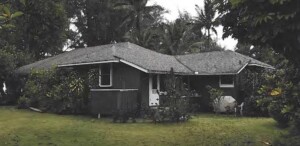 Princeville Ranch Manager’s House & Caretaker’s Cottage, Kaua‘i
Princeville Ranch Manager’s House & Caretaker’s Cottage, Kaua‘i
The Princeville Ranch Manager’s House and Caretaker’s Cottage, built in 1941 and 1960, respectively, are significant as the site where native Hawaiian and Polynesian settlers have been gathering as a community for generations to catch and distribute schools of smaller fish that enter Hanalei Bay each summer using a traditional method known as Hukilau. The Manager’s house is also the first home built in a group of three nearly identical homes on Hanalei Bay by Lihue Land Company. As wealth expanded from the production of rice (and later sugar and pineapple), Hanalei was transitioning from an agriculturally-based community to a leisure resort population.
 The Princeville Ranch Manager’s House is significant for its association with both Robert “Bobby” Trent Jones, Jr. and his father, Robert Trent Jones, Sr., a famous golfer and golf course designer responsible for designing 270 golf courses worldwide. Jones Jr. designed the Princeville Golf Courses there in 1968. It is also significant under Criterion C as one of the last remaining residential examples of a simple Hawaiian Plantation Style Beach House, built with the highest quality of Redwood materials and craftsmanship on Hanalei Bay, Kaua‘i.
The Princeville Ranch Manager’s House is significant for its association with both Robert “Bobby” Trent Jones, Jr. and his father, Robert Trent Jones, Sr., a famous golfer and golf course designer responsible for designing 270 golf courses worldwide. Jones Jr. designed the Princeville Golf Courses there in 1968. It is also significant under Criterion C as one of the last remaining residential examples of a simple Hawaiian Plantation Style Beach House, built with the highest quality of Redwood materials and craftsmanship on Hanalei Bay, Kaua‘i.


